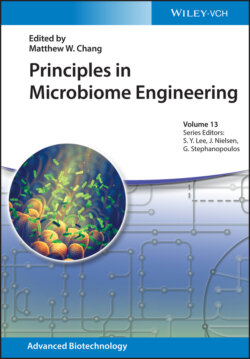Читать книгу Principles in Microbiome Engineering - Группа авторов - Страница 43
1.3.3 Cancer
ОглавлениеMany studies concluded that the microbiota plays a role in cancer pathogenesis in humans. It is further demonstrated that the dietary nutritional content facilitates the behavior of the microbiome. Prebiotics‐containing fiber (soluble and insoluble) helps to move the bowel by bulking up the intestinal lumen and absorbing carcinogens such as nitrosamines, thus limiting the contact time of the carcinogens to the GI epithelium tissue. These fibers also house the SCFA‐producing microbes, enriching the Gram‐positive anaerobic Firmicutes population and providing the substance for microbial fermentation [215–218]. The two most abundant butyrate‐producing Firmicutes in the human colon are E. rectale/Roseburia spp. and F. prausnitzii. E. rectale/Roseburia spp. belongs to the Clostridium coccoides (or Clostridial cluster XIVa) cluster, and F. prausnitzii belongs to the C. leptum (or Clostridial cluster IV) cluster [219–222].
The SCFA butyrate can prevent gut tissue inflammation and suppress cancer cell motility by deactivating Akt/ERK signaling pathway of histone deacetylase in colorectal cancer and lymphoma cancer [223]. Butyrate also exerts its anticancer activity by interfering with the mitochondrial and exogenous apoptotic pathways through regulating oncogenic signaling molecules through microRNAs and methylation [224, 225]. On top of generating butyrate, these bacteria can produce other metabolites such as lactic acid and formic acid that can further exert anticancer activities [226].
Cruciferous plant–rich diet was also found to help in the prevention of colorectal cancer. Cruciferous vegetables are enriched with glucosinolates, a precursor to the anticancer agent isothiocyanates. These glucosinolates require to be catalyzed by the enzyme myrosinase to form its isothiocyanate derivatives. A study showed that cruciferous‐rich and fruit‐rich diet enriches certain groups of Actinobacteria, Firmicutes, and Bacteroides that have weak myrosinase‐like properties [227]. Other approaches to augment the myrosinase activity were achieved using engineered microbes such as E. coli Nissle 1917 [228]. Other means of dietary regulation also reduce the risk of developing cancer by the displacement of pathogens associated with cancer pathogenesis. Colon cancer patients were found to have an enriched population of Fusobacterium nucleatum compared to healthy test subjects detected in both colorectal biopsies and patient stool samples [229–233]. F. nucleatum from the phyla Fusobacteria is a Gram‐negative non‐spore‐forming bacilli that is strictly anaerobic and is usually found in the mouth, playing a role in various diseases such as periodontitis, appendicitis, gingivitis and invasive infections in the other organs. Studies showed that F. nucleatum exerts the cancer pathogenesis through the interaction of three biomolecules located on the surface of the microbe: lipopolysaccharide (LPS), adhesin A (FadA), and fusobacterium autotransporter protein 2 (Fap2) [234]. Fiber‐enriched and low‐fat diet can reduce the risk of F. nucleatum‐positive colorectal cancer through the displacement of the pathogen from the gut; however, the dietary change does not show any significant improvements in F. nucleatum‐negative cancer patients [235]. These studies suggest the role of diet pattern in displacing F. nucleatum, thus negating the risk of colorectal cancer development, showing the relationship between diet, microbiome, and cancer pathogenesis.
